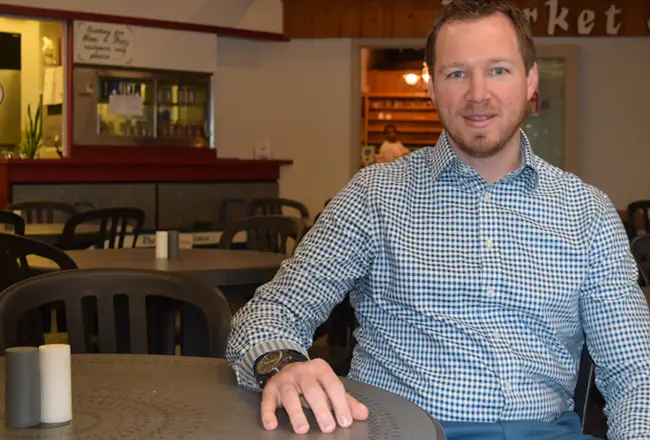Suite Talk: Scott Dolch, executive director of the Connecticut Restaurant Association

Scott Dolch is relatively new to the restaurant industry. Before taking on the role of executive director at the Connecticut Restaurant Association last April, he held sales, marketing and communications positions for the Travelers Championship, the University of Connecticut, the University of Massachusetts Lowell and the University of Hartford. While he was in college, he gained local prominence as the starting quarterback who led Central Connecticut State University to its first Northeast Conference championship in 2004.
Dolch”™s background in creating cogent messaging, coupled with his thinking-on-his-feet ability to overcome oncoming challenges, has helped him bring a greater visibility and vibrancy to his organization. In this edition of Suite Talk, Business Journal reporter Phil Hall visited with Dolch at his office in Farmington to discuss Connecticut”™s restaurant environment.
What is the state of today”™s restaurant industry in Connecticut?
“I think it”™s in a good place. When you look at growth we”™ve had year-over-year increases in the number of restaurants over the last three to four years. I think there are some growing concerns from the legislative side and the economy, as well as the challenges of running a small business in the state and being successful. Being brick and mortar, restaurants don”™t have the ability to pack up and move to another state. A lot of them have been here a very, very long time.”
According to your association”™s data, there are 8,037 restaurants in the state. Isn”™t that rather high for a rather small state?
“I don”™t think so. We have a large population in a small state. If you look at Fairfield County, it is a suburb of New York City and it continues to grow. In New Haven, we”™re seeing growth there. There are definitely opportunities for some more growth.”
What percentage of Connecticut restaurants are members of your association?
“The membership share is about 10 to 15 percent. One reason I was hired was to grow the number of members in our state. I try to get down to Fairfield County at least two to three times a month, to see members and board members in that area. In the shoreline, we have to grow our numbers. For anyone working in the industry, we try to be that voice for them. If you look at Massachusetts or Rhode Island or New York, the membership numbers (for their state associations) are in the 30, 40 or 50 percent range. They are much bigger associations.”
Is the majority of Connecticut restaurants independently owned or are they franchises?
“The vast majority are independently owned. But it depends on the segment. If you are talking about quick-service restaurants, even though some people might say, ”˜Oh, it”™s Dunkin Donuts or McDonald”™s or Chipotle”™ and you see the national name, they are franchise owners ”” they are not corporately owned. They are owned by people who care about what”™s going on in Connecticut and how it affects the way it runs their business.
“Eighty-five to 95 percent of our members are small-business owned. Even with Subway in Milford, all of the 366 restaurants that Subway has in this state are franchisees ”” individual owners, some who might own 10 to 15 restaurants, but they are still small-business owners.”
What have been some of the more interesting challenges running a restaurant in Connecticut, especially in view of the state”™s distinctive economic environment?
“People from the outside looking in might think they understand this industry, but restaurant owners are working off a 3- to 5-percent profit margin. I don”™t think legislators really get that. They might think, ”˜Oh, they”™re making so much money,”™ but in fact they are making three to five cents off the dollar. As the state continues to find ways to tax more or increase labor costs substantially and very quickly, how are these owners going to be able to come up with that and be able to survive? They are looking to either cut hours or increase food costs.
“Our state is one of the few where the tipped wage is coupled with the minimum wage. That is the wage the server can receive before tips. The tipped wage here is $6.38 per hour. If their tips don”™t exceed minimum wage, the restaurant owners owe that to them. We have national numbers showing that on average the median wage for a server is $21 an hour. One of the big conversations we have in Connecticut is that if we push the minimum wage up to $15, the tipped wage goes to about $9.54, almost a $3 increase for every server for every hour. If you talk about the 3- to 5-percent profit margin, restaurant owners will have to make decisions about dishwashers and line cooks regarding their wages or how many employees they can have.
“Our industry does matter. Ten percent of our economy is the restaurant industry and it”™s tough to be a successful restaurant. We want successful restaurants to open another location and to grow. I don”™t want to take a step back. Any time additional financial issues are added to the plate, it is worrisome.”
What are some of your nonlegislative goals for the association?
“We”™ve never had a James Beard Award winner out of Connecticut. As a competitive person that bothers me. There are chefs in Connecticut that I feel aren”™t being given their due. We need to continue to expose and promote and brand the talent we have. The greatest thing about our small state is that you can get all around the state pretty easily in day trips.
“As we continue to grow our numbers we can find our next generation of talented restaurant owners and chefs. We support ProStart, which is a national high school culinary program. We have 1,000 kids in the state who are a part of it and we look forward to growing the next generation of leaders in this industry.”